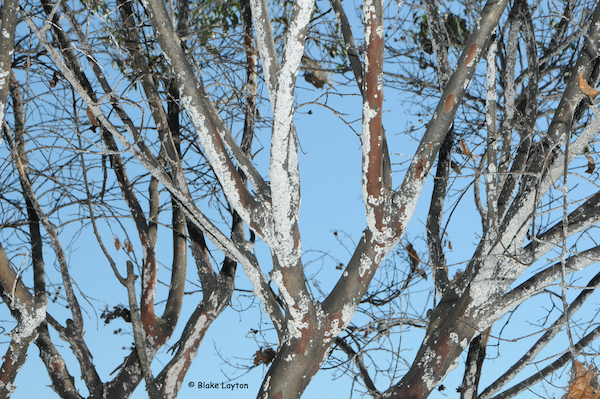Crape Myrtle Bark Scale, Vol. 7, No. 4
Related News
April 11, 2013
April 2, 2013
March 14, 2013
February 28, 2013

If the trunks of your crape myrtles and the ground or mulch underneath look like they have been powdered with chimney soot, they are probably infested with crape myrtle bark scale (CMBS). This is a serious new pest of crape myrtle that has been in the state about six years now, with confirmed infestations in at least 24 counties. Unfortunately, CMBS is easily spread when infested plants are brought into a new area, and once it is established in an area, the flightless crawlers can quickly spread to nearby trees by hitching rides on birds, large insects like cicadas, lawn equipment and wind. Fortunately, CMBS only attacks crape myrtles and a very few other plants, like American beautyberry.
Crape myrtles are one of the most popular landscape plants in the South, fitting a landscaping niche that can be filled by relatively few other species. Traditionally, crape myrtles have been free of serious disease and insect pests, but that situation changed with the arrival of CMBS. Because this scale has few natural enemies here, they quickly develop huge populations, producing large amounts of honeydew and sooty mold and causing infested trees to be unsightly and to grow and bloom poorly. These insects don’t just make crape myrtles look bad; they also affect shrubs and other plants growing nearby, resulting in heavy accumulations of black sooty mold on these plants as well. Check out the pictures and information in the publication referenced below so you will be able to recognize CMBS if it shows up in your landscape. This is an easy pest to recognize. Fortunately, it is also an easy pest to control, at least for now.
Control: The best way to control CMBS is to avoid bringing infested plants into an area or landscape in the first place. Work closely with your nursery or landscape contractor to be sure any crape myrtles you purchase are CMBS free.
For trees that are already infested, systemic insecticides such as imidacloprid, dinotefuran, or thiamethoxam applied as soil drenches or soil injections are the best treatments available. Late March through May is the best time to treat, but treatments can be applied anytime an infestation is detected and trees are still actively growing. Because these treatments do not give 100% control, plan on treating trees again the following year—even if you don’t see any scale.
These treatments are easy to apply. Just measure the tree, add the required amount of insecticide to a bucket or watering can, stir in a couple gallons of water and pour this mixture right around the base of the tree. Rake mulch away from the tree before treating, if necessary to reach the soil, and put it back when finished. When applied correctly, a single treatment should give effective, season-long control. The insects will be controlled within a few weeks but expect it to take a few months for accumulations of black, sooty mold and dead scale covers to weather away.
See extension publication 2938, Crape Myrtle Bark Scale, Identification and Control , for more information. This publication contains tables with recommended insecticides for both home and commercial application, including brand names, treatment rates and instructions on how to use these soil-applied products.
Blake Layton, Extension Entomology Specialist, Mississippi State University Extension Service.
The information given here is for educational purposes only. Always read and follow current label directions. Specific commercial products are mentioned as examples only and reference to specific products or trade names is made with the understanding that no discrimination is intended to other products that may also be suitable and appropriately labeled.
Mississippi State University is an equal opportunity institution.
Bug’s Eye View is now on Facebook. Join the Bug's Eye View Facebook group here.